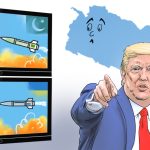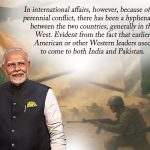The echoes of Operation Sindoor—India’s precision airstrikes on terrorist camps across the Line of Control—have faded from the headlines. Still, their geopolitical tremors continue to reverberate across the region. While the primary theatre of conflict was Pakistan, a far more calculated observer stood watching from the shadows: China. What happened in the aftermath of May 7, 2025, wasn’t just a recalibration of India-Pakistan hostility. It was a moment of revelation for the China–Pakistan alliance—a test of its depth, flexibility, and endurance in the face of military confrontation and diplomatic pressure. In the days that followed the Indian strikes, Beijing issued carefully worded calls for restraint and dialogue. There was no condemnation of the Pahalgam massacre, no censure of cross-border terrorism. Instead, seemingly neutral, China’s response betrayed a deeper strategy: maintain plausible deniability while safeguarding the axis that sustains instability in South Asia.
This alliance is not a recent convenience; it is a carefully engineered dependency. From Gwadar to Gilgit, from Huawei fibre optics in Balochistan to Chinese drones in Pakistani skies, Beijing has hardwired itself into Islamabad’s military and economic nervous system. Pakistan may claim sovereignty, but increasingly, it resembles a client state—dependent, deferential, and diplomatically obedient. Far from merely being an “all-weather friend,” China has become the strategic backbone supporting Pakistan’s regional assertiveness.
The military reaction of Pakistan to the Indian strikes was predominantly dependent on Chinese equipment. The introduction of Chinese-manufactured J-10C fighter jets, LY-80 missile systems, and radar networks highlighted Beijing’s pivotal role in enhancing Pakistan’s military capabilities. Reports of collaborative military performance assessments and confidential evaluations with Chinese advisors further demonstrate Beijing’s commitment to operationalising its defence exports, not merely as commerce, but as a means of geostrategic influence.
Pakistan’s economic flexibility has diminished. Islamabad, burdened by substantial debt and facing diplomatic isolation, possesses few alternatives beyond Beijing. This financial dependency, exacerbated by Chinese loans within the CPEC framework and the growing reliance on Chinese enterprises for digital infrastructure, indicates that, even without ostentatious new initiatives, China’s influence intensifies. In contrast to the IMF, China’s conditions are ambiguous and are conducted bilaterally. In contrast to Western benefactors, China demands allegiance rather than changes.
Narrating a Nation: Feat. India and Pakistan
This commitment is most evident in silence, especially about Xinjiang. Notwithstanding its vocal assertions of Muslim solidarity, Pakistan has declined to condemn the Chinese Communist Party’s treatment of Uyghur Muslims. There is increasing evidence that Pakistan has deported Uyghur dissidents or obstructed their attempts to seek sanctuary, succumbing to pressure from Beijing. This is not merely strategic realpolitik; it constitutes moral capitulation.
Additionally, there exists the diplomatic shield. China has once more obstructed India’s efforts to impose sanctions on Pakistan-based terrorist organisations at the United Nations, employing procedural impediments to hinder consensus. The Shanghai Cooperation Organisation has opposed ideas for a collaborative counter-terrorism team. China’s stance is unequivocal: it will persist in shielding Pakistan from international condemnation while presenting itself as a responsible participant.
The Realignment of the Global Political Chessboard: Repercussions for China
Is this helping Pakistan or trapping it? The irony lies in Pakistan’s attainment of temporary diplomatic protection and material assistance, which ultimately results in a loss of long-term autonomy. It increasingly serves as more of a client for Chinese interests, not necessarily a sovereign, militarily advantageous, economically reliant, and diplomatically expedient one. Strategically, Pakistan is emerging as China’s primary outpost in a region that Beijing perceives as a laboratory for influence expansion. India cannot afford to regard this axis as a transient issue. The China–Pakistan cooperation has evolved from mere friendship to a strategic alignment against India’s ascendance. New Delhi must acknowledge that every act of terrorism, border conflict, and international impasse increasingly bears the influence of Beijing. Whether actively organised or strategically permitted, these are not parallel developments; they represent converging threats.
A few strategic imperatives arise. India should persist in internationalising the Pakistan issue—not via sporadic indignation, but via sustained interaction with Western, Gulf, and East Asian nations that have become apprehensive of Pakistan’s deceit. Simultaneously, India must address China’s opportunism with equal resolve, both by establishing technology alliances with nations such as Taiwan and Vietnam and by exposing the moral hypocrisy inherent in China’s counter-terrorism rhetoric. India’s strategic deterrence should encompass not only missiles and drones but also narratives, partnerships, and the establishment of norms.
The China-Pakistan partnership has long been unrecognised as a mere reactive coalition of convenience. Sindoor signifies far more than its superficial appearance. It is a systematic, stratified, and mutually supportive agreement that flourishes in times of crisis. It is not disturbed by confrontation; rather, it thrives on it. Pakistan-China axis post Operation Sindoor has been jolted by a few factors, which include the questionable quality of air defence provided by China, which India was able to penetrate for four continuous days. Pakistan’s disappointment in this case has been a bigger reason for the jolt. Nevertheless, it will remain emboldened for the only reason: Pakistan’s economic and political vulnerabilities and Chinese support for it.
(Harsh Pandey is pursuing his PhD at the School of International Studies, Jawaharlal Nehru University, New Delhi)











